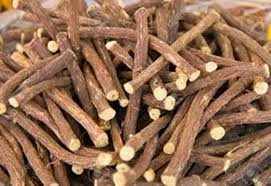ATHIMATHURAM-அதிமதுரம்
Common name: Licorice, Liquorice, Sweetwood • Hindi: jethi-madh, kubas-susa, mithilakdi • Kannada: atimadhura, jestamaddu • Malayalam: atimadhuram, erattimadhuram • Marathi: jashtimadh • Sanskrit: jalayashti, klitaka, madhu, madhu-yashtikam • Tamil: adimaduram • Telugu: athimathuram • Urdu: mulhatti, mulathi
Licorice is the root of the glycyrrhiza glabra plant, a legume that sprouts purple and blue flowers.
The licorice plant is native to Europe and parts of Asia. Licorice and licorice extract can be found whole, sliced, and in powder and liquid forms.
The root has a brown, bark-like exterior and yellow interior and is 50 times sweeter than sugar.
.JPG)
 For cosmetic purposes, licorice root can be used to reduce inflammation and to combat aging. It hydrates, soothes, and brightens skin, and helps reduce the appearance of age spots. A common herbal remedy in Asia for a variety of ailments, it is eaten and used as flavoring in Europe.
You’ll find it in rejuvenating lotions and creams, acne products, makeup, eye treatments, soaps, skin-brightening products, and cleansers. It is also sold as a tea, cut in slices for chewing, and used as a flavor agent in candies, drinks, and tobacco products.
Other uses: Chewing on slices of licorice root is said to relieve sore throats, dry coughs, and help with respiratory problems
For cosmetic purposes, licorice root can be used to reduce inflammation and to combat aging. It hydrates, soothes, and brightens skin, and helps reduce the appearance of age spots. A common herbal remedy in Asia for a variety of ailments, it is eaten and used as flavoring in Europe.
You’ll find it in rejuvenating lotions and creams, acne products, makeup, eye treatments, soaps, skin-brightening products, and cleansers. It is also sold as a tea, cut in slices for chewing, and used as a flavor agent in candies, drinks, and tobacco products.
Other uses: Chewing on slices of licorice root is said to relieve sore throats, dry coughs, and help with respiratory problems
 .The licorice plant is a perennial herb, growing up to 1 m in tall, with pinnate leaves about 7-15 cm long, with 9-17 leaflets. The flowers are 0.8–1.2 cm long, purple to pale whitish blue, produced in a loose inflorescence. The fruit is an oblong pod, 2-3 cm long, containing several seeds. The flavor of liquorice comes mainly from a sweet-tasting compound called anethole, an aromatic, unsaturated ether compound also found in anise, fennel, and other herbs. Additional sweetness in liquorice comes from glycyrrhizic acid, an anti-viral compound sweeter than sugar. Liquorice flavouring is also used in soft drinks, and in some herbal teas where it provides a sweet aftertaste. The flavour is common in medicines to disguise unpleasant flavours.
.The licorice plant is a perennial herb, growing up to 1 m in tall, with pinnate leaves about 7-15 cm long, with 9-17 leaflets. The flowers are 0.8–1.2 cm long, purple to pale whitish blue, produced in a loose inflorescence. The fruit is an oblong pod, 2-3 cm long, containing several seeds. The flavor of liquorice comes mainly from a sweet-tasting compound called anethole, an aromatic, unsaturated ether compound also found in anise, fennel, and other herbs. Additional sweetness in liquorice comes from glycyrrhizic acid, an anti-viral compound sweeter than sugar. Liquorice flavouring is also used in soft drinks, and in some herbal teas where it provides a sweet aftertaste. The flavour is common in medicines to disguise unpleasant flavours.
Medicinal uses: Liquorice may be useful in conventional and naturopathic medicine for both mouth ulcers and peptic ulcers. In traditional Chinese medicine, liquorice is commonly used in herbal formulae to "harmonize" the other ingredients in the formula and to carry the formula to the twelve "regular meridians" and to relieve a spasmodic cough. (114)
Common name: Licorice, Liquorice, Sweetwood • Hindi: jethi-madh, kubas-susa, mithilakdi • Kannada: atimadhura, jestamaddu • Malayalam: atimadhuram, erattimadhuram • Marathi: jashtimadh • Sanskrit: jalayashti, klitaka, madhu, madhu-yashtikam • Tamil: adimaduram • Telugu: athimathuram • Urdu: mulhatti, mulathi
Licorice is the root of the glycyrrhiza glabra plant, a legume that sprouts purple and blue flowers.
Other uses: Chewing on slices of licorice root is said to relieve sore throats, dry coughs, and help with respiratory problems
Medicinal uses: Liquorice may be useful in conventional and naturopathic medicine for both mouth ulcers and peptic ulcers. In traditional Chinese medicine, liquorice is commonly used in herbal formulae to "harmonize" the other ingredients in the formula and to carry the formula to the twelve "regular meridians" and to relieve a spasmodic cough. (114)

Comments